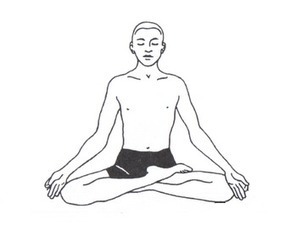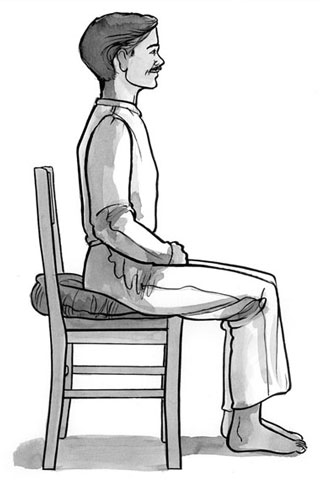Buddhist meditation techniques
Focus on the breath – counting or not counting
What if you aren’t pursuing enlightenment?
Actually there are countless meditations in the different Buddhist schools and traditions. Again I feel that you will develop concentration and mindfulness from the simple breathing technique. While Buddhists traditionally believe the path to enlightenment involves other training beyond meditation, it is certainly the single tool you can use effectively to bring a sense of well being and relaxation to your life.
The four foundations for mindfulness
The Buddha spoke of and categorized the four foundations for mindfulness as body, feelings, states of mind and mental objects. Meditating on the sub-groups of these four has the goal of developing insight. Our focus on the breathing and increased awareness of the thoughts, feelings and sensations that arise from beyond our control will ultimately increase our mindfulness.
In Buddhism a regular meditation practice has the goal of both a serene and tranquil state as well as insight; the aforementioned vipassana. If your practice unfolds as Buddhists believe, as you develop peace and serenity you will be more capable of supressing hindrances that exist in your life. By not being hindered you will be clear enough to have insight (like cleaning the mirror) to gain wisdom and find liberation and enlightenment.
Throughout the numerous schools of practice in Buddhism throughout the centuries one sees the same common practice of breath meditation though in Chinese Buddhism the practice of repeating the name of the Buddha out loud or in your mind only is found. This was done in order to have laser focus and leave no room for any other thought ultimately allowing the mind to remain peaceful. So whatever technique you practice may be influenced not only by your comfort with the practice but the ultimate result you seek.
The meditative practice of constantly watching and being aware of the breath will absolutely develop laser focused power of concentration, whether you add the counting of the in and out breaths or not.
Concentration on object meditation
It may be that concentrating your focus on a single point/object is a more effective technique. You may want to try to see if you are more responsive to simply focusing on an object in the room (whether a Buddha icon/statue or any item) and therein placing your consistent and unwavering attention. Please expect that as is the case with the breath awareness exercise you will constantly have thoughts pull your attention away from the object. Simply realize that it is so and return to your complete visual and mental focus on the object in question.
Make your focus as pin point as possible so that there is no darting of the eyes. Do not strain the eyes, simply look at the object. Try initially for a few minutes daily, gently and gradually building to 20 minutes daily.
If as the Buddha taught that we are suffering because we are unable to see what truly is then by developing mindfulness by choosing on a regular basis to simply focus on the breath and become fully aware from moment to moment then inner peace is absolutely achievable.
Ready to begin meditating
Are you ready? Find somewhere quiet. Turn off all phones and alarms. Give yourself permission to be fully involved for 20 minutes or a set amount of time. If there are others in your household let them know you need this time. Commit to this daily. Sit down and close you eyes. Try to keep your back straight. Relax your jaw. Relax your body. Hands can simply be held in your lap with palms facing upwards. Try to breathe from your belly not your chest. Focus your attention on your breath. Follow the rise and fall. The in – breath and the out – breath.
If a thought or image takes you away from the awareness of your breath, simply notice that it is happening and return to the awareness of your breath. Do not even allow a milli-second to judge your inability to remain focused on the breath. It will become easier as time passes. Trust in that and return to the awareness of your breath. It’s that simple. There is nothing else to do. You are capable of doing this 100%.
Dealing with interruptions during meditation
Whatever interrupts — the thought of someone, a task you need to do, the thought of a bill that needs to be paid, a regret, the memory of how you handled a situation poorly – just notice that it has interrupted your awareness of your breath and return. Just notice that it has happened and without self judgement return to the awareness of your breath.
As you continue your practice of meditating by watching the breath you will find as the days pass that you are more aware as you move through the world. You will notice things outside and inside of you with more clarity and depth.
You will find over time that you are increasingly grounded in the moment and as a result more aware of negative thoughts that have led you to suffer in the past. The Buddha believed that we suffer because we want what we do not already have and you will find in the moment that you desire less and less for happiness. Awareness really is curative!
If you choose to count breaths then on the in breath count 1 in your mind and on the out breath count 1 again. With the next breath do the same; 2 in your mind on the in breath and 2 on the exhale as well. Continue this with 3, 4, 5 etc. then start again once you reach 10. Focusing on the number may keep distracting thoughts from overtaking your meditation process but again, if it does just notice it is so and resume counting.
The advantage of this method is that the counting fills the space normally occupied by worry, fears and anticipating. My preference is not to count as it involves the intellect. I choose to simply become aware of the sensation of breathing as it is drawn in and as it leaves the body.
You could also choose to just be aware of the temperature of the breath; the warm and just focus on that. Or focus on the subtle movement of the ribcage again returning to that focus when a though tries to distract.
Importance of body position
Body position in your meditation is not as important as the practice itself.
If the traditional lotus or cross legged positions are too difficult and distracting, simply sit on a chair. Lotus position
Lotus position
 Half Lotus
Half Lotus
 Chair sitting meditation
Chair sitting meditation
It is better to consistently sit on a chair and still your mind rather than refrain from meditating because the position is uncomfortable. It has been said that even the Buddha told one of his followers with posture issues to lay down on his back if it meant he would meditate!
When should I meditate?
Forget the debate of when is the best time to meditate. Meditate when it is right for you. The advantage of the morning meditation is that it will center you to withstand the onslaught of the world from your morning activities or commute onward.
It’s imperative that you have patience with yourself as you attempt to incorporate meditating into your daily life. Early on it will seem like you are unable to remain focused on the practice. Your mind is not used to being tamed and will resist. Be gentle with yourself and trust in the process knowing that over time your earnestness will make the difference.
As the days and months go by you experience improved well-being. You will respond to stressful situations more decisively and correctly. You will notice a great decrease in any prevailing general anxiety as your cortisol levels actually lower. Your mind will be clearer and your ability to recognize your motives and the motives of others with greater clarity.
Patience needed as you begin to meditate
Your meditation practice will require patience. The one thing that we can learn to control is how we choose to react to the thoughts that appear in our minds but a regular meditative practice is necessary. Just persist in allowing the practice to bring you clarity and peace of mind.
In your meditation practice there is nothing to gain or become or to achieve. Buddhists feel that meditation will lead to the liberation of the mind from thoughts and events beyond your control. If you are earnest you will find that this is so. Trust the process and watch what happens!